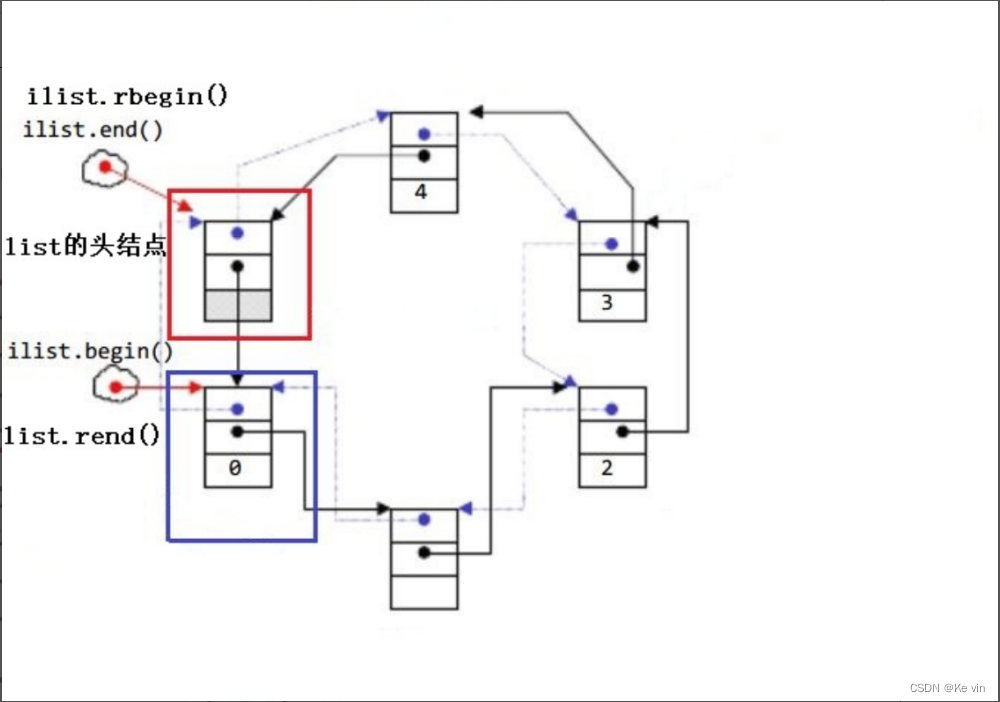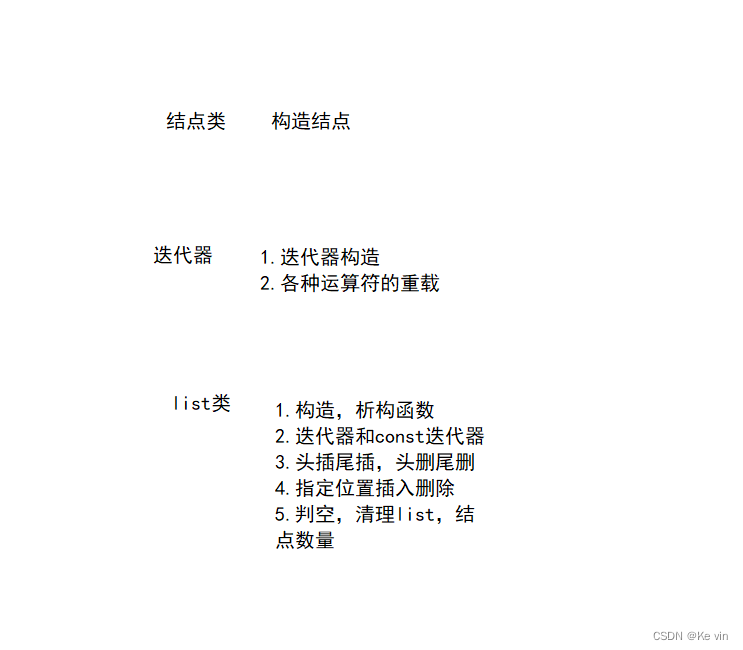list的模拟实现(模仿STL)
目录
一、模拟实现前的准备
1.list结构认识
2.迭代器的实现不同
3.如何实现需要的功能
二.结点类实现
三.迭代器实现
1.实现前的问题
2._list_iterator类的成员变量和构造函数
3.*和->运算符重载
4.前置++和后置++的实现
5.前置--和后置--
6.==和!=运算符重载
四.list类的实现
1.list类和构造函数
2.析构
3.拷贝构造函数
4.赋值运算符重载
5.迭代器
6.insert()
7.erase()
8.clear()
9.头插头删,尾插尾删
10.判空
五.完整代码
一、模拟实现前的准备
1.list结构认识
1.STLe的list的底层结构其实是带头结点的双向循环链表,双向链表中每个元素存储在互不相关的独立节点中,在节点中通过指针指向其前一个元素和后一个元素。

2.迭代器的实现不同
list插入元素不会导致迭代器失效,删除元素时,只会导致当前迭代器失效,其他迭代器不受影响。list的迭代器是自定义类型对原生指针的封装,模拟指针的行为,那为什么不像vector那样直接用原生指针呢?因为list的每个结点在物理结构上面不是连续的,直接对结点++,其得到的不是下一个结点指针。
3.如何实现需要的功能
这里我们可以用三个类来模拟实现,结点类和list迭代器类用struct封装,因为我们不需要对其做访问限制,而list类就用class类封装。

二.结点类实现
结点类实现比较简单,不过我们需要注意:
(1)需要用到模板,方便以后使用不同的类型;
(2)结点成员变量包括,结点值、指向前一个结点的指针,指向后一个结点的指针;
(3)不需要析构函数(没有额外申请空间);
(4)用struct来实现,对访问不做限制
template<class T> //list的结点结构,对访问不做限制,所以用structstruct list_node{list_node<T>* _next; //成员变量list_node<T>* _prev;T _data;list_node(const T& x = T()) //构造函数:_next(nullptr), _prev(nullptr), _data(x){}};
三.迭代器实现
list的迭代器实现是整个实现过程中最精彩的部分,尤其是模板里的多个参数,可谓是把规则用到了极致,涉及到的知识点也非常多,我们不得不感叹STL大佬的实力。
1.实现前的问题
迭代器分为普通迭代器和const迭代器,之前的迭代器由于是直接用的原生指针,所以就算两种迭代器分开实现,其代码量夜很小。但是对于_list_iterator类要实现的普通的_list_iterator和const版本的_list_const_iterator,因为对于两个类中的部分函数有普通函数和const函数之分(如begin( )和end( )),其他并无区别。因为这两个类的大部分代码相似,那么怎么解决呢?
查看STL源码,我们可以发现,用下面的方法非常不错:
迭代器模板用到了三个参数
template<class T, class Ref, class Ptr>list在实例化时,通过不同的参数实例出两个类,一个是普通的不带const的T,T&, T*,另一个是带const的T,const T&, const T*,其中Ref是引用,Ptr是指针,该类模板实例化了以下这两个类模板:
typedef __list_iterator<T, T&, T*> iterator; //非const 迭代器typedef __list_iterator<T, const T&, const T*> const_iterator; //const迭代器这样我们就解决了代码冗余的问题(大佬不愧是大佬)。
2._list_iterator类的成员变量和构造函数
成员变量只有结点node,构造函数负责初始化结点
template<class T, class Ref, class Ptr>struct __list_iterator{typedef list_node<T> node; //typedef __list_iterator<T, Ref, Ptr> self;node* _node; //成员变量__list_iterator(node* n) //构造函数:_node(n){}};3.*和->运算符重载
Ref operator*()
{
return _node->_data; //解引用之后,我们需要得到拷贝的值,所以返回引用
}Ptr operator->()
{
return &_node->_data; //结构体指针解引用,返回结点指针
}
注意:It->_data,(It是一个迭代器)我们平时这样用没问题,但是我们要知道这里其实省略了一个->,It->其实就是It.operator->(),其返回值是_data*类型,我们还需要It.operator->()->_data,但是为了可读性,编译器优化了一个箭头。
4.前置++和后置++的实现
self& operator++() //都需要用到自身,所以是self
{
_node = _node->_next;
return *this;
}self operator++(int)
{
self tmp(*this);
_node = _node->_next;
return tmp;
}5.前置--和后置--
self& operator--(){_node = _node->_prev;return *this;}self operator--(int){self tmp(*this);_node = _node->_prev;return tmp;}6.==和!=运算符重载
bool operator!=(const self& s){return _node != s._node;}bool operator==(const self& s){return _node == s._node;}四.list类的实现
1.list类和构造函数
template<class T>class list //list类{typedef list_node<T> node;public:typedef __list_iterator<T, T&, T*> iterator; //非const 迭代器typedef __list_iterator<T, const T&, const T*> const_iterator; //const迭代器//typedef __list_const_iterator<T> const_iterator;list(){_head = new node; //默认构造函数_head->_next = _head;_head->_prev = _head;}private:node* _head; };2.析构
复用了后面的函数
~list(){clear();delete _head;_head = nullptr;}void clear(){iterator it = begin();while (it != end()){//it = erase(it);erase(it++);}}3.拷贝构造函数
void empty_init() //空初始化{_head = new node;_head->_next = _head;_head->_prev = _head;}list(const list<T>& lt){empty_init();for (auto e : lt){push_back(e);}}4.赋值运算符重载
(1)现代的赋值运算符重载
void swap(list<T>& tmp){std::swap(_head, tmp._head);}list<T>& operator=(list<T> lt){swap(lt);return *this;}在执行赋值运算符重载时,会调用拷贝构造函数执行深拷贝,然后再交换两个链表头节点的指针,把this要释放的资源交给临时对象,临时对象出了swap的函数作用域就被this要释放的资源也会被同时释放。
5.迭代器
iterator begin(){//iterator it(_head->_next);//return it;return iterator(_head->_next); //匿名对象}const_iterator begin() const{return const_iterator(_head->_next);}iterator end(){return iterator(_head);}const_iterator end() const{//iterator it(_head->_next);//return it;return const_iterator(_head);}6.insert()
先构造一个结点,然后插入
void insert(iterator pos, const T& x){node* cur = pos._node;node* prev = cur->_prev;node* new_node = new node(x);prev->_next = new_node;new_node->_prev = prev;new_node->_next = cur;cur->_prev = new_node;}7.erase()
删除后,需要返回删除位置的下一个结点
iterator erase(iterator pos){assert(pos != end());node* prev = pos._node->_prev;node* next = pos._node->_next;prev->_next = next;next->_prev = prev;delete pos._node;return iterator(next);}8.clear()
不能把哨兵卫清理了,否则链表就不存在了
void clear(){iterator it = begin();while (it != end()){//it = erase(it);erase(it++);}}9.头插头删,尾插尾删
这里直接复用insert()和erase()
void push_back(const T& x){insert(end(), x);}void push_front(const T& x){insert(begin(), x);}void pop_back(){erase(--end());}void pop_front(){erase(begin());}10.判空
bool empty()
{return end()==begin();
}五.完整代码
#pragma once
#include<assert.h>
#include<iostream>namespace bit
{template<class T>struct list_node{list_node<T>* _next;list_node<T>* _prev;T _data;list_node(const T& x = T()):_next(nullptr), _prev(nullptr), _data(x){}};// 1、迭代器要么就是原生指针// 2、迭代器要么就是自定义类型对原生指针的封装,模拟指针的行为template<class T, class Ref, class Ptr>struct __list_iterator{typedef list_node<T> node;typedef __list_iterator<T, Ref, Ptr> self;node* _node;__list_iterator(node* n):_node(n){}Ref operator*(){return _node->_data;}Ptr operator->(){return &_node->_data;}self& operator++(){_node = _node->_next;return *this;}self operator++(int){self tmp(*this);_node = _node->_next;return tmp;}self& operator--(){_node = _node->_prev;return *this;}self operator--(int){self tmp(*this);_node = _node->_prev;return tmp;}bool operator!=(const self& s){return _node != s._node;}bool operator==(const self& s){return _node == s._node;}};template<class T>class list{typedef list_node<T> node;public:typedef __list_iterator<T, T&, T*> iterator;typedef __list_iterator<T, const T&, const T*> const_iterator;//typedef __list_const_iterator<T> const_iterator;iterator begin(){//iterator it(_head->_next);//return it;return iterator(_head->_next);}const_iterator begin() const{return const_iterator(_head->_next);}iterator end(){return iterator(_head);}const_iterator end() const{//iterator it(_head->_next);//return it;return const_iterator(_head);}void empty_init(){_head = new node;_head->_next = _head;_head->_prev = _head;}list(){empty_init();}template <class Iterator>list(Iterator first, Iterator last){empty_init();while (first != last){push_back(*first);++first;}}// lt2(lt1)/*list(const list<T>& lt){empty_init();for (auto e : lt){push_back(e);}}*/void swap(list<T>& tmp){std::swap(_head, tmp._head);}list(const list<T>& lt){empty_init();list<T> tmp(lt.begin(), lt.end());swap(tmp);}// lt1 = lt3list<T>& operator=(list<T> lt){swap(lt);return *this;}~list(){clear();delete _head;_head = nullptr;}void clear(){iterator it = begin();while (it != end()){//it = erase(it);erase(it++);}}void push_back(const T& x){/*node* tail = _head->_prev;node* new_node = new node(x);tail->_next = new_node;new_node->_prev = tail;new_node->_next = _head;_head->_prev = new_node;*/insert(end(), x);}void push_front(const T& x){insert(begin(), x);}void pop_back(){erase(--end());}void pop_front(){erase(begin());}void insert(iterator pos, const T& x){node* cur = pos._node;node* prev = cur->_prev;node* new_node = new node(x);prev->_next = new_node;new_node->_prev = prev;new_node->_next = cur;cur->_prev = new_node;}iterator erase(iterator pos){assert(pos != end());node* prev = pos._node->_prev;node* next = pos._node->_next;prev->_next = next;next->_prev = prev;delete pos._node;return iterator(next);}bool empty(){return end()==begin();}private:node* _head;};
}